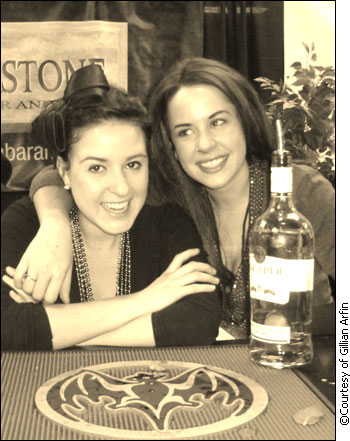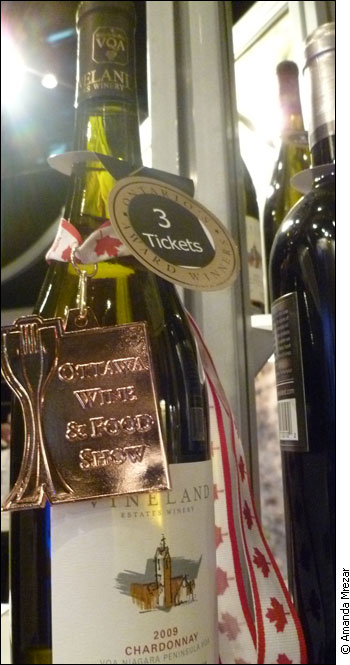Tags
Related Posts
Share This
Ontario’s wines toast better days ahead?
I never thought drinking on the job would be acceptable…until this occasion of the most-looked-forward-to drinking event in Ottawa. From the moment one enters Lansdowne Stadium, the notion that ours is the city that fun forgot becomes a distant and misinformed mockery of this very enthusiastic (and, at the moment, red-faced) crowd. Immediately approaching me are my 20-something-year-old friends, tongues as purple as the grapes I saw in Hartman’s for $3.29 a pound earlier today.
“OHMYGOD! Have you seen the guys in here?” they ask me, with more than just excitement adding to their drawl.
They were absolutely right. On this Friday night, quarter after six, the very crowded stadium field brims with sleek, male government workers in handsome suits (Government of Canada tags strategically half-hanging from their pockets). Groups of women, coddling their male colleagues, are in their winter best. All are dressed to impress at this year’s 25th annual Ottawa Wine and Food Show.

Bartender Tiffany Gagné at the booth of the Ottawa restaurant Steak. Only 10 percent of Steak’s wine list is Canadian.
For its first 22 years, the show was owned and operated by Halina and Robert Player, under the corporate banner Player Expositions. The Players built the show with little support from Ottawa’s foodies—it was even suggested by one food writer, said Mr. Player in an interview years ago, that Ottawa “wasn’t ready for that kind of show.” Yet, not long after the show’s humble beginnings, it gained momentum, and has for many attracted more than 26,000 people annually. In 2008, Ottawa businesswoman Joan Culliton became sole owner of the show. Averaging over 200 exhibitors and featuring over 1,400 wines, spirits and beers, in addition to foods from across the world, the show claims to mirror Canada’s—specifically Ottawa’s—“vibrant culinary scene.”
I attempt to explore and get my tasting on, which I soon realize will not be easy for someone barely 5-feet-3-inches short. I shuffle through a towering herd all heading the same way as I, toward the ticket-sale booth. One sheet of 50 tickets costs $20, with each “sample” glass of wine, pint of beer or shot of vodka or Patrón (a luxury tequila) ranging between three and eight tickets (eight was unusual: vintage wine). Put into perspective, that’s a lot of booze for a little pocket-change. I notice the man in front of me proudly showcasing his cufflinks, shaped like wine bottles and purchased specifically for the occasion. From the way he’s bragging to the woman on his left arm, I guess that they’re on a return trip to the ticket booth.

The reporter (left), with a friend and fellow wine enthusiast, takes a breather amid an arduous evening of sampling.
The rows of booths are crowded with people busy with their hand-to-stem, nose-to-glass, sniff-swirl-sip routine. Servers hired by the Wine and Food Show run around tirelessly with large bins in an effort to clear the miniature wine glasses from the tables…and benches… and garbage-can lids… and floors…
Meanwhile, chefs from Le Cordon Bleu hurriedly prep their food, with the smell of garlic, cheese and fish harmonizing into one surprisingly tantalizing scent. The wine and food reps bustle (each with company dog tags hanging from his or her neck), trying to barter the coveted lobster poutine in exchange for glasses of Chardonnay.
And while the guests are drunk with happiness, the chefs thrilled to be cooking their best and the wine reps keen on hawking their products, a lonesome booth in a dark corner—near the inside of the truck-unloading bay, at the building’s far end—is being outshone (literally) by other, better lit booths.
Welcome to “Wine Country Ontario,” featuring a string of 20 Niagara wineries. Despite its chipper reps behind the counter, the booth is egregiously overshadowed by Wolfblass, LCBO and the like. How could this happen?
“Booths take bucks,” explains Ken Burton, President of the Ontario Wine Society. “You spend more, you have your choice of prime space.”
To me, the Ontario wine booth’s forlorn situation symbolizes Ontario’s wine problem generally: Across the world and especially in Canada, we’re underperforming; we’re under-appreciated. Ontario delivers some fine wines, but even Canadian consumers look elsewhere. I decide to ask why.
The LCBO: Friend or Foe to Ontario Wine?
Rod Phillips—wine author, Ottawa Citizen wine columnist and Carleton University professor of the History of Alcohol—co-chaired the show’s wine competition, having drawn up new protocols for 2010. He says that Ontario wineries have been internationally recognized for exactly one product: icewine. Yet it too remains on the shelves.
“It might be iconic,” says Phillips. “No one buys it.”

Ottawa wine pundit Rod Phillips
co-chaired the 2010 competition.
He says, “The problem with Ontario wine production is that Ontario has yet to find its niche: something other than icewine. They’re trying to grow everything, and people are just not tuned in enough.”
And it’s not just uninvolved consumers and a fuzzy focus on product that are to blame. Endemic problems in retailing also play a role, according to Phillips: “There aren’t many channels [in Ontario] for wine to be sold.”
On this economic question, I maintain that the Liquor Control Board of Ontario (LCBO) is a foe to the wine community. Due in part to its structural problems, or perhaps because it is a Crown corporation whose goal it is to generate profit for the government, it has reportedly posed difficulties to small wineries in putting their wines on its shelves, thus limiting the wineries’ sales outlets to restaurants and the wineries’ own stores. The reality is that for the LCBO, it is cheaper to purchase a mass-market wine from California than it is to stock a Riesling from the Niagara region. As our once Prime Minister Mulroney said to former American President Reagan, “You drink our beer, and we’ll drink your wine.”
Furthermore, Ontario wineries face legal impediments in getting their wine to the public, according to Shirley-Anne George, founder of the Alliance of Canadian Wine Consumers. That’s why since November 2010 George has spearheaded “Free My Grapes,” an Ottawa-based movement.

A bronze medal at the show went to Ontario’s Vineland Estate Chardonnay, available for sample for a meagre three tickets.
“Free My Grapes” is a group of concerned wine consumers who will challenge a Canadian law, the Importation of Intoxicating Liquors Act (last revisited in 1928), which prohibits the sale of wine directly from wineries to consumers across provincial borders. To put it into context, George explains, “I can bring home two bottles of wine from Argentina, but can go to jail for bringing home a bottle from British Columbia or Quebec.”
George says the group is working toward personal exemptions for individuals looking to buy wine cross-provincially. She says the dismissal of this archaic law would not only provide another avenue for sales, but “would encourage people to visit wineries within the country,” instead of travelling outside of Canada to wineries in California, for example.
Wine and Food Show owner and producer Joan Culliton wrote that she is pleased to announce that, for autumn 2011, “the Show will become the Ottawa Wine and Food Festival—an extended five full days of tasting and celebrating local, national and international wines, beers, spirits and cuisine.” Maybe by then, through continual efforts by united winos throughout Ontario, that lonesome corner booth—perched sadly in the corner like a forgotten party guest—will shine a little brighter. Cheers to hoping, for next year’s Ottawa Wine and Food Festival.
Related Links
“What you’ll be pouring in your glass in 2011”- Globe and Mail





